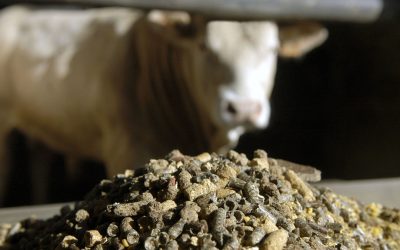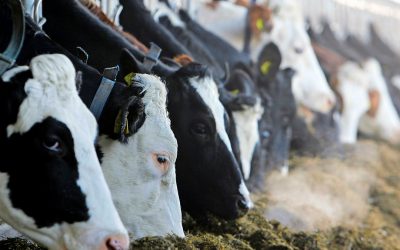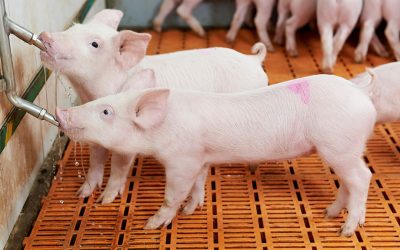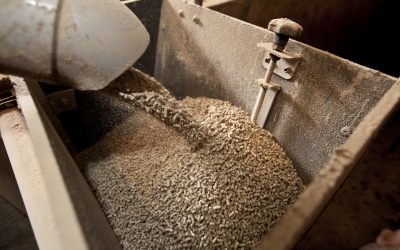Sloten BV downsizes batches and increases efficiency
Powerful weighing instrumentation and automation systems increase efficiency and flexibility in animal feed production. With a new weighing solution, the batching and blending plant of milk replacer manufacturer Sloten BV has increased efficiency, flexibility, and production capacity.
Dutch company Sloten BV in 1958 produced the first “rearing milk” for calves. Today, calf milk replacers are still the mainstay of products for the company. Over the years the company added other feeds for calves, lamb, foal, piglets and goat kids. Sloten is a global leader in dairy based feed ingredients and milk replacers for calves and young animals with its brands Sprayfo, Nuklospray and Spraymes that are sold in over 60 countries.Sloten BV has two production facilities in Sloten and Deventer, the Netherlands. The company upgraded the blending and batching system to an integrated solution in their Deventer facility. Close collaboration of the Sloten engineering team, system integrator Actemium, and Siemens teams from Canada, Germany and the Netherlands made for a smooth operation of what could have been an arduous and tricky project.
Downsizing batch volumes
The facility in Sloten produces a milk powder with a high fat content. Raw materials coming from the dairy industry are processed into semi-finished products using a computer-controlled process that involves mixing of raw materials in liquid form, pasteurisation, homogenisation and spray-drying. After this process the semi-finished goods are transported to the Deventer manufacturing unit where they are processed into the end products.Bulk carriers transport the powder to the Deventer facility for batching with other ingredients. “In Deventer we store the ingredients in twenty silos,” says technical manager Bart Lekkerkerker. “From the silos, the ingredients are transported to our in-line blending process, which consisted of twelve stand-alone weighfeeders; there was no integration with the other operations in the plant.”Each weighfeeder was pre-fed by a bunker with a rotary feeder serving as a volumetric discharge. Sloten wanted to increase production capacity and have the capability to make smaller batches. “Traditionally we make large batches up to 300 tonnes; however, we see a growing demand for smaller batches,” says Lekkerkerker. Sloten defined a need for a new blending and batching system with a higher accuracy, and one that could be integrated into the present Enterprise Resource Planning (ERP) environment of the plant.The weighfeeders are the core of the production plant in Deventer. The amount of downtime while replacing the system needed to be as short as possible in order to reduce productivity losses.
Integrated solution
Siemens offered an integrated solution with 14 high accuracy Milltronics 600 Series SD (sanitary duty) weighfeeders integrated into the process control system Simatic PCS 7. Simatic IT joins the new batching and blending system with the ERP environment. Siemens supplied the 600 Series weighfeeders complete with drives, load cells and motors.
The 600 Series stainless steel platform weighdeck with ultra high molecular weight (UHMW) plastic slider bar assembly mounts directly to two corrosion-resistant, sealed load cells. The direct load design eliminates all intermediate mechanical suspension and allows material weight to be directly applied to the load cells, resulting in a maintenance free weighing system with no hysteresis. The frame of the 600 Series is sturdy and rigid, ensuring stable and repeatable results, maximising resolution and weighing accuracy. The weighfeeder is designed for the food industry where high-pressure washdown is required. It meets all USDA and FDA requirements.The weighfeeders blend and batch 14 different products at the same time. The weighfeeders are fed with ingredients from the bunkers, weighing the batches with an accuracy of 0.5%. The speed of the belt and the belt loading determine the correct dosage. To avoid a high turndown in belt loading, the depth of material on the belt is adjusted automatically for the different materials. The shear gate level positioner is powered by a Siemens Posmo multi-step drive. Siwarex FTC modules accurately determine the feed rate and, through the PCS 7, control the belt speed automatically according to the process readings and the established set points.
Disconnected bunkers
In the old situation the bunkers were physically placed on the weighfeeders. In the new design they are no longer connected in order to increase accuracy. The bunkers are supported by Siwarex load cells to allow measurement of the filling levels. The weighfeeders have an extra weighdeck at the weighfeeder inlet area in order to measure product left on the belt when the weighfeeder is being stopped. Both the bunker and the extra weighdeck load cells are connected to Siwarex U processor modules. “There is no more need to have weighfeeders and bunkers run dry at the end of a batch, as we continuously measure the amount of product,” according to Lekkerkerker. The result is faster programming time between batches and reduction of product losses to zero.Siwarex U is a versatile weighing module for all simple weighing and force measuring tasks, which is either used centrally or as in this case de-centrally linked via Profibus DP to a Simatic S7-400 system. Siwarex FTC is a flexible weighing module for belt scales and weighfeeders with measurement applications such as belt speed, flow rate, and material loading. These processor modules, connecting the bunkers and the weighfeeders, link into Simatic PCS 7 via Profibus DP.
Standard components
The complete system is constructed with standard components. The 600 Series weighfeeders were pre-cabled, tested, and calibrated before installation. The compact design of the weighfeeders made it relatively easy to fit them in their respective locations – the old weighfeeders were of varying sizes and the existing space was limited. Only the coordination between the weighfeeders needed to be done after installation. The result was a shutdown of just seven days and loss of only one small batch in the first test run. Standard components also means they are easy to maintain and replace, e.g. the free standing, cantilevered construction of the weighfeeders allows for changing of the belt without taking the frame apart. The 600 Series weighfeeder is designed to eliminate material build-up, ensuring high accuracy and reliability. The weigh system reduces dead load and applies live load directly to two load cells. Load cells are externally mounted for easy access and maintenance.
The recipes for the batches are made with special software, and are loaded into Simatic IT, which subsequently forwards them to PCS 7, that controls the batching system through the processor modules. “In the past the recipes were programmed into the system manually – this is an enormous time-saver,” states Lekkerkerker. Siwarex weighing systems are ideal for high accuracy verification weighing. The system, consisting of a processor and one or more load cells, can be applied throughout the manufacturing process. The weighing modules are designed for direct integration into a Simatic automation system in either central or distributed configurations. The weighing modules and processors integrate seamlessly into the process control system. The users can freely configure their automation solution – including the scale application – and run diagnostics on the load cells and weighfeeders. The configuration package and the off-the-shelf application software can be used for the easy implementation of customised and industry-specific solutions. Sloten now has a freely programmable weighing and proportioning system that the company can adapt to changing operational requirements.For the operators the starts and stops of the weighfeeders, as well as the changes from one product to the other are far simpler now than in the previous configuration. During the retrofit the complete control system was changed to Simatic PCS 7, complete with all its functions. The operators felt comfortable with it right from the start. The overall system is more or less intuitive and training was barely needed.“With the Siemens weighing solution we have increased our efficiency, flexibility and production capacity in a fast and smooth way,” concludes Lekkerkerker, “which helps for a healthy bottom line.”











